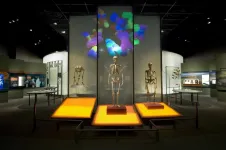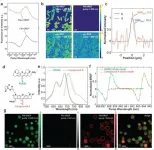(Press-News.org) Meaningful legislation addressing health care inequities in the U.S. will require studies examining potential health disparities due to geographic location or economic status.
An interdisciplinary team at the Medical University of South Carolina (MUSC) and the University of South Carolina (UofSC) report in the Journal of Public Health Dentistry that rural children are less likely to receive preventive dental care than urban children. Using samples from 20,842 respondents from a 2017 National Survey of Children's Health, the team determined the existence of an urban-rural disparity in U.S. children's oral health. This disparity can have serious consequences for children's oral health.
"When preventive care is delayed, the persistent exposure to things like refined sugars can promote bacterial growth," said Amy Martin, DPH, a professor in the College of Dental Medicine at MUSC and senior author of the article. "When that bacteria grows, it can exacerbate the cycle of decay, which can only be disrupted by visiting the dentist for regular cleanings and parent education."
The findings of this particular study are important to informing legislative change. Preparations for the 2020 Surgeon General's report on oral health are currently underway. The original report, released in 2000, was a pivotal call to action to prioritize oral health in the U.S. As a result of this report, significant pieces of legislation were passed that addressed the nation's inequities.
However, work still needs to be done to address inequities in oral health care for children. The National Advisory Committee on Rural Health and Human Services has also released oral health reports in response or as a prelude to the Surgeon General's reports. In 2003, its report found that fewer rural children visited dentists annually than urban children. This statistic motivated the MUSC-UofSC team to investigate whether health disparities still existed between rural and urban children.
"There has not really been a comprehensive study on what's happening among rural children, compared to their urban counterparts, in the last five years," commented lead author Elizabeth Crouch, MD., Ph.D. , assistant professor and deputy director of the Rural and Minority Health Research Center in the Arnold School of Public Health at UofSC. "This article may influence policy decisions in the near future."
To understand oral health discrepancies between rural and urban children, the investigators used data from the 2017-2018 National Survey of Children's Health, a nationally representative sample of children from the U.S. Along with collecting information about geographic location, family income, oral health condition, family structure and race, the survey asked about access to oral health care: Had a participant's child received oral health care? Did the child regularly see a health care provider for preventive care such as checkups and dental cleanings?
The investigators found that rural children were less likely to have had a preventive dental visit than urban children. Furthermore, compared with urban kids, they were less likely to receive fluoride treatments or dental sealants, and their teeth were in poorer condition.
"It's really important for researchers to examine access, utilization and outcomes among racial ethnic minorities and vulnerable populations living in rural areas," said Crouch. "Unless we quantify these differences, there's no way to know what kinds of policies that we need to be advocating for."
Additionally, children who were uninsured or had caregivers with a high school education or less were less likely to have had preventive dental visits. These finding suggest that to improve preventive care in kids, policies should focus on increasing family income or dental insurance coverage.
Importantly, this study confirmed previous studies that found racial/ethnic minorities were less likely to receive preventive dental care than nonminorities.
"Ultimately, illuminating these disparities, both quantitatively and qualitatively, will inform policy that can eliminate these disparities in oral health care in rural children," said Crouch.
INFORMATION:
About MUSC
Founded in 1824 in Charleston, MUSC is the oldest medical school in the South as well as the state's only integrated academic health sciences center with a unique charge to serve the state through education, research and patient care. Each year, MUSC educates and trains more than 3,000 students and nearly 800 residents in six colleges: Dental Medicine, Graduate Studies, Health Professions, Medicine, Nursing and Pharmacy. The state's leader in obtaining biomedical research funds, in fiscal year 2019, MUSC set a new high, bringing in more than $284 million. For information on academic programs, visit musc.edu.
As the clinical health system of the Medical University of South Carolina, MUSC Health is dedicated to delivering the highest quality patient care available while training generations of competent, compassionate health care providers to serve the people of South Carolina and beyond. Comprising some 1,600 beds, more than 100 outreach sites, the MUSC College of Medicine, the physicians' practice plan and nearly 325 telehealth locations, MUSC Health owns and operates eight hospitals situated in Charleston, Chester, Florence, Lancaster and Marion counties. In 2020, for the sixth consecutive year, U.S. News & World Report named MUSC Health the No. 1 hospital in South Carolina. To learn more about clinical patient services, visit muschealth.org.
MUSC and its affiliates have collective annual budgets of $3.2 billion. The more than 17,000 MUSC team members include world-class faculty, physicians, specialty providers and scientists who deliver groundbreaking education, research, technology and patient care.
After pouring beer into a glass, streams of little bubbles appear and start to rise, forming a foamy head. As the bubbles burst, the released carbon dioxide gas imparts the beverage's desirable tang. But just how many bubbles are in that drink? By examining various factors, researchers reporting in ACS Omega estimate between 200,000 and nearly 2 million of these tiny spheres can form in a gently poured lager.
Worldwide, beer is one of the most popular alcoholic beverages. Lightly flavored lagers, which are especially well-liked, are produced through a cool fermentation process, converting the sugars in malted grains to alcohol and carbon dioxide. During commercial packaging, more carbonation can be added to get a desired level of fizziness. That's ...
(Boston)--A major obstacle in understanding and treating posttraumatic stress disorder (PTSD) is its clinical and neurobiological heterogeneity. In order to better treat the condition and address this barrier, the field has become increasingly interested in identifying subtypes of PTSD based on dysfunction in neural networks alongside cognitive impairments that may underlie the development and maintenance of symptoms.
VA and BU researchers have now found a marker of PTSD in brain regions associated with emotional regulation. "This marker was strongest in those with clinically impaired executive function or the ability to engage in complex ...
Careful criminals usually clean a scene, wiping away visible blood and fingerprints. However, prints made with trace amounts of blood, invisible to the naked eye, could remain. Dyes can detect these hidden prints, but the dyes don't work well on certain surfaces. Now, researchers reporting in ACS Applied Materials & Interfaces have developed a fluorescent polymer that binds to blood in a fingerprint -- without damaging any DNA also on the surface -- to create high-contrast images.
Fingerprints are critical pieces of forensic evidence because their whorls, loops and arches are unique to each person, and these patterns don't change as people age. When violent crimes are committed, a culprit's fingerprints inked in ...
Water touches virtually every aspect of human society, and all life on earth requires it. Yet, fresh, clean water is becoming increasingly scarce -- one in eight people on the planet lack access to clean water. Drivers of freshwater salt pollution such as de-icers on roads and parking lots, water softeners, and wastewater and industrial discharges further threaten freshwater ecosystem health and human water security.
"Inland freshwater salt pollution is rising nationwide and worldwide, and we investigated the potential conflict between managing freshwater salt ...
Screening for a sometimes fatal condition among patients with a rare autoimmune disease could soon - thanks to a computer algorithm - become even more accurate.
Researchers at Michigan Medicine found that an internet application improved their ability to spot pulmonary arterial hypertension in patients with systemic sclerosis, or scleroderma. The unpredictable condition is marked by tightening of the skin that can damage internal organs.
The algorithm, aptly named DETECT, outperformed standard methods used to identify the form of high blood pressure in the lungs that causes the heart to weaken and fail.
"We've been advocating for a long time that every scleroderma patient should be screened on an annual basis using DETECT, and ...
BETHESDA, Md. -- The COVID-19 pandemic heavily influenced spending on prescription drugs in the U.S. in 2020, according to the ASHP's (American Society of Health-System Pharmacists) National Trends in Prescription Drug Expenditures and Projections for 2021. Shifts in care related to the pandemic will continue to be a significant driver of drug expenditures in 2021, along with uptake in the use of biosimilars, a large pipeline of new cancer drugs, and increased approvals of specialty medications.
Prescription drug spending in 2020 grew at a moderate rate of 4.9% to $535.3 billion. Increased utilization drove the ...
Published in the Advanced Functional Materials, University of Minnesota researcher Hongbo Pang led a cross-institutional study on improving the efficacy of nucleotide-based drugs against prostate cancer and bone metastasis.
In this study, Pang and his research team looked at whether liposomes, when integrated with the iRGD peptide, will help concentrate antisense oligonucleotides (ASOs) into primary prostate tumors and its bone metastases. Liposomes are used as a drug carrier system, and ASOs are a type of nucleotide drug.
More importantly, they investigated whether this system ...
DUARTE, Calif. -- Scientists at City of Hope, a world-renowned independent research and treatment center for cancer and diabetes, have developed a novel, noninvasive liquid biopsy test for detecting lymph node metastasis in individuals with high-risk T1 colorectal carcinoma. Research on the development of the blood test was reported in a END ...
A new study is the first-ever to identify the genes for creativity in Homo sapiens that distinguish modern humans from chimpanzees and Neanderthals. The research identified 267 genes that are found only in modern humans and likely play an important role in the evolution of the behavioral characteristics that set apart Homo sapiens, including creativity, self-awareness, cooperativeness, and healthy longevity. The study, led by an international and interdisciplinary team of researchers from the American Museum of Natural History and Washington University among other institutions, is published today in the journal Molecular Psychiatry.
"One of the most fundamental questions about ...
It has been a long pursuit to develop super-resolution imaging techniques for Raman microscopy, which has intrinsic advantages of chemical specificity over the fluorescence counterpart. Despite the perceived importance and extensive research efforts, true super-resolution (defined as diffraction-unlimited) Raman imaging of biological systems in the optical far-field remains challenging due to the deficiency in sensitivity for conventional Raman scattering. Consequently, those reported super-resolution vibrational imaging methods have to base on excitation saturating, ...






